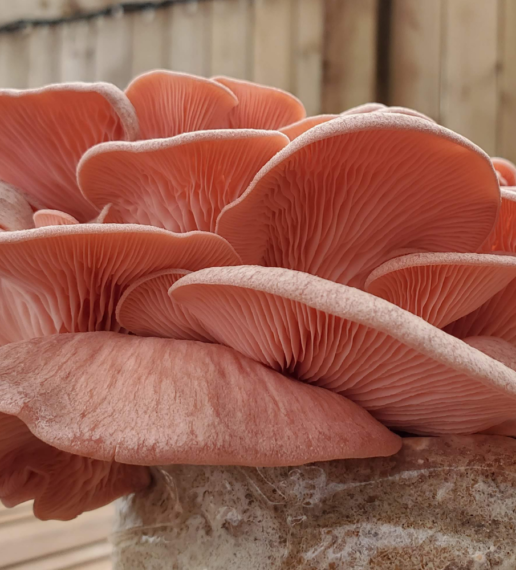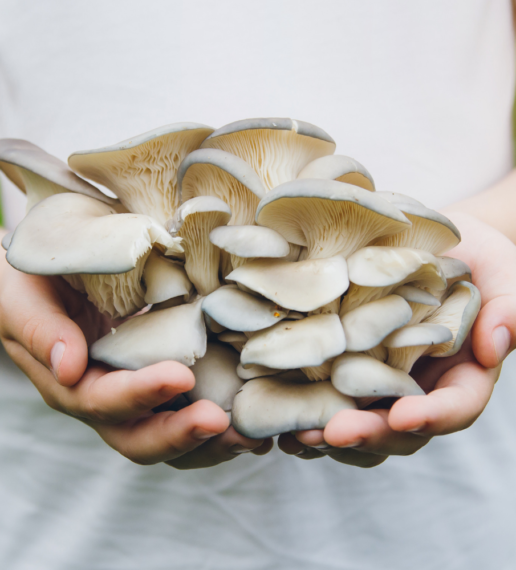Growing Blog
Candidates For Cultivation: The Blue Oyster Mushroom

Few mushrooms are more satisfying to watch grow as the Blue Oyster Mushroom.
It is very forgiving and easy to grow making it the ideal choice for a beginner. The fruits grow rapidly, sometimes doubling in size everyday.
The mushroom starts out strikingly blue and turns grey as it matures.
These mushrooms are ideal candidates for outdoor growing as their fresh air requirements are the highest of any of the mushrooms we have grown.
Scientific Name:
Pleurotus ostreatus
General Description:
The blue oyster mushroom grows in large clusters and takes on the typical shelf like shape of the Pleurotus species.
The size and shape can vary immensely depending on the growing conditions. Blue Oyster mushrooms required a extremely high level of fresh air exchange, more so than any other mushroom commonly cultivated.
Grown in a high CO2 environment, the Blue Oyster mushroom will have a long and thick stems with small caps.
They also have a huge spore load, which can quickly fill your grow room with a thick spore load.
The mushroom clusters start out with deep blue coloring and eventually turn grey as they age. The fruit is usually thick and meaty and very versatile for culinary uses.
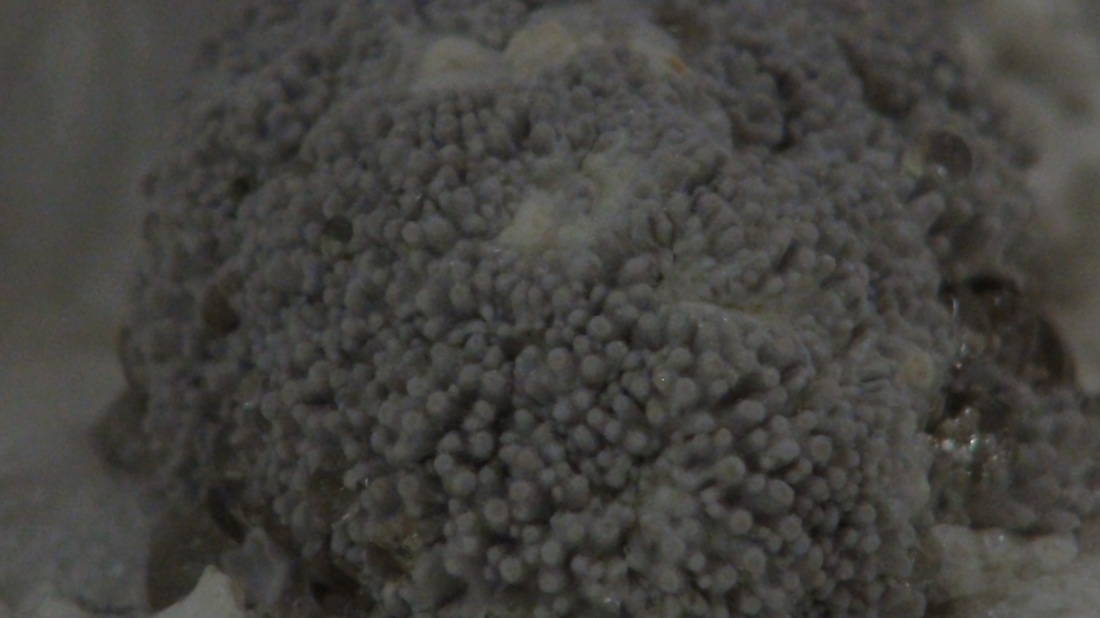
Blue Oyster mushroom primordia.
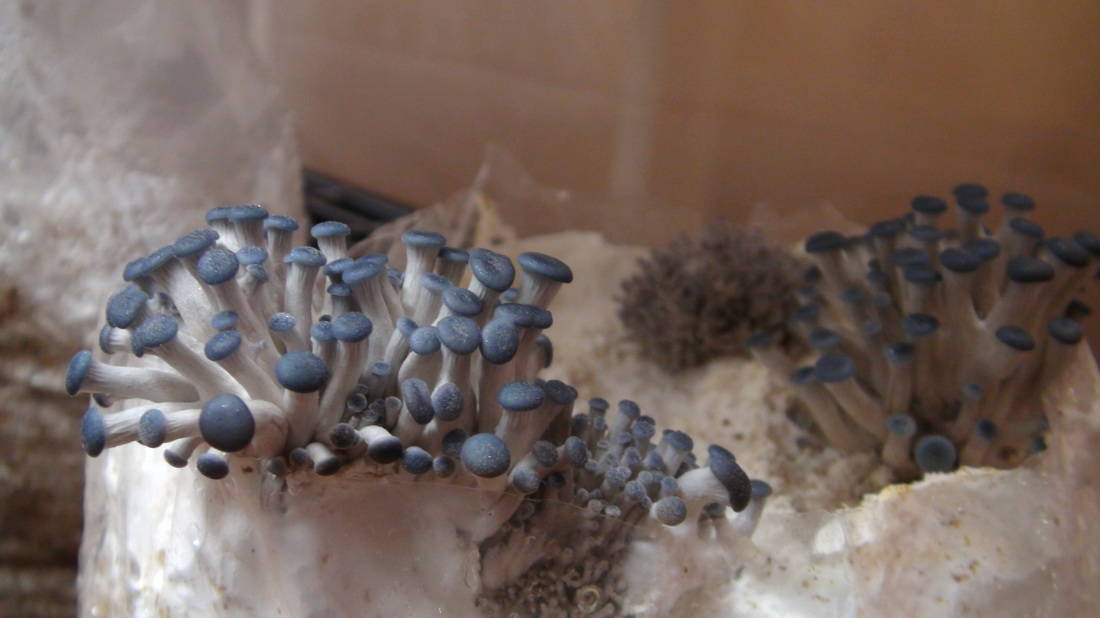
Blue Oyster growing in sawdust. The Long Stems indicate high CO2,
Natural Habitat:
Found on hardwood logs trees and stumps, living, dying and decaying. Common throughout North America. Found in the spring and the fall.
Difficulty of Cultivation:
Easy, beginner.
Agar:
Blue Oyster mushrooms grow vigorously on Agar. They seem to prefer malt yeast agar.
Growth can be rhizomorphic and eventually gets thick and fluffy.
Blue Oyster mycelium has a tendency to emit a brown/orange metabolite, which can often be mistaken for contamination, although it could be a sign that the mycelium is fighting off contamination.
Spawn Types:
Rye grain works best, but sawdust spawn can also be used. Some report higher yields on straw if sawdust spawn is used in lieu of grain spawn. Oyster spawn has a unique mushroomy scent. Easily broken up through shaken for no fuss spawning to bulk substrates.
Blue Oyster spawn has a tendency to sweat, producing pockets of water in your spawn bags or grain jars.
Try to position your spawn so that grain is not sitting soaking in water when colonizing,
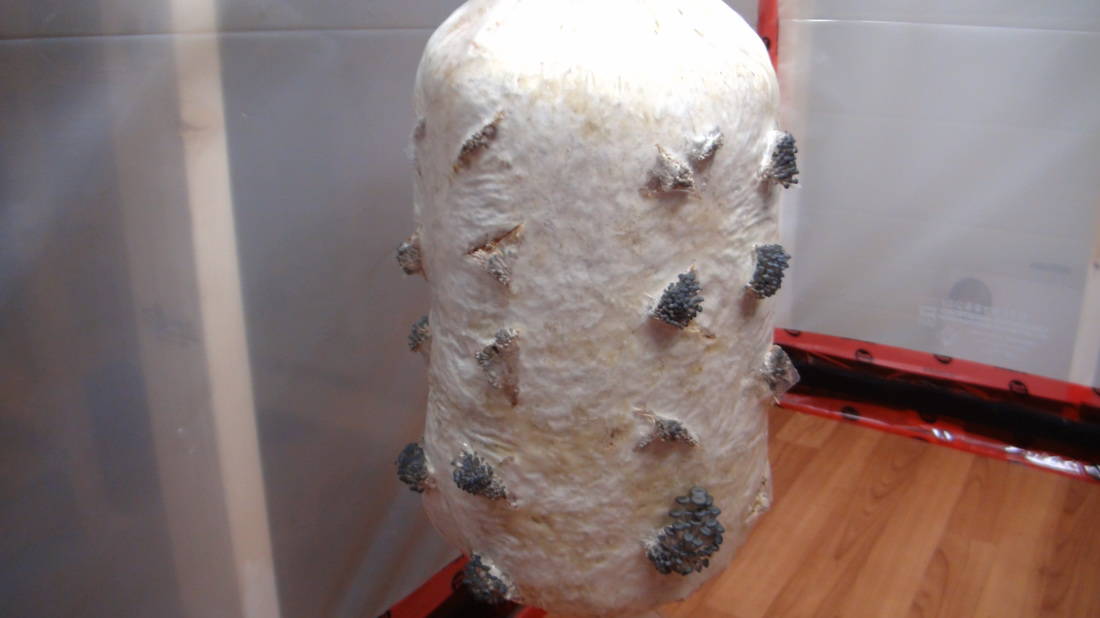
Young Blue Oysters emerging on a straw log indoors.
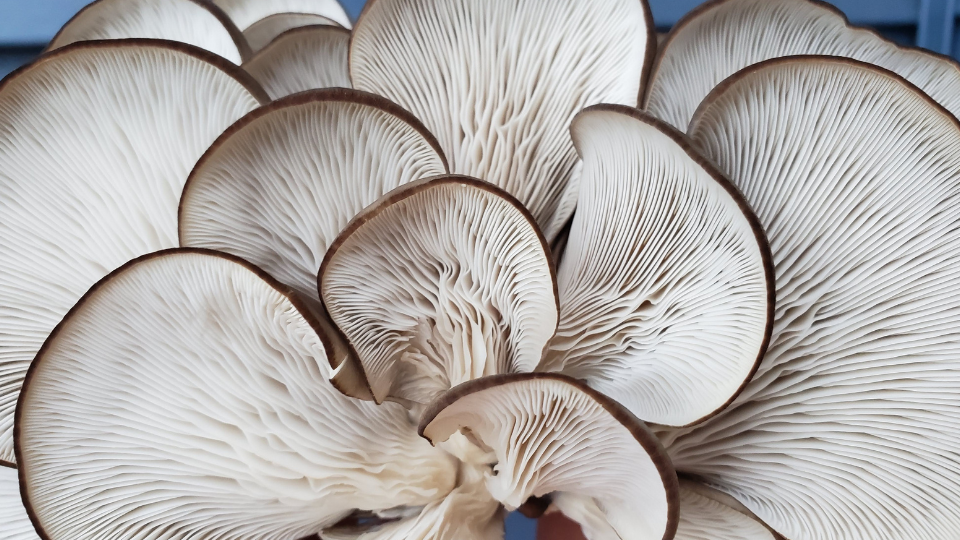
A close up of the gills of the Blue Oyster Mushroom.
Substrate Types:
Pasteurized straw logs are extremely effective for Blue Oyster mushrooms. Use a higher spawn rate for better yields. Straw logs will produce multiple flushes if contamination can be kept at bay.
Supplemented sawdust blocks also work quite well, but straw is likely to produce similar results more economically.
Blue Oyster mushrooms will devour almost anything and can even be grown on coffee grounds, waste paper, sugar cane, grass and many other waste industrial products.
Fruiting Containers:
Use poly tubing for straw logs, 16″ lay flat diameter.
Too thick a straw log will cause the center of the log to become anaerobic and eventually contaminate.
Grow bags work by cutting slits in the side of the bag for mushrooms to grow through, or simply by cutting off the top of the bag and allowing fruits to form on the top of the block.
Blue Oyster mushrooms are incredibly versatile and can be also grown in 5 gallon buckets with holes drilled, or any container you can think of.
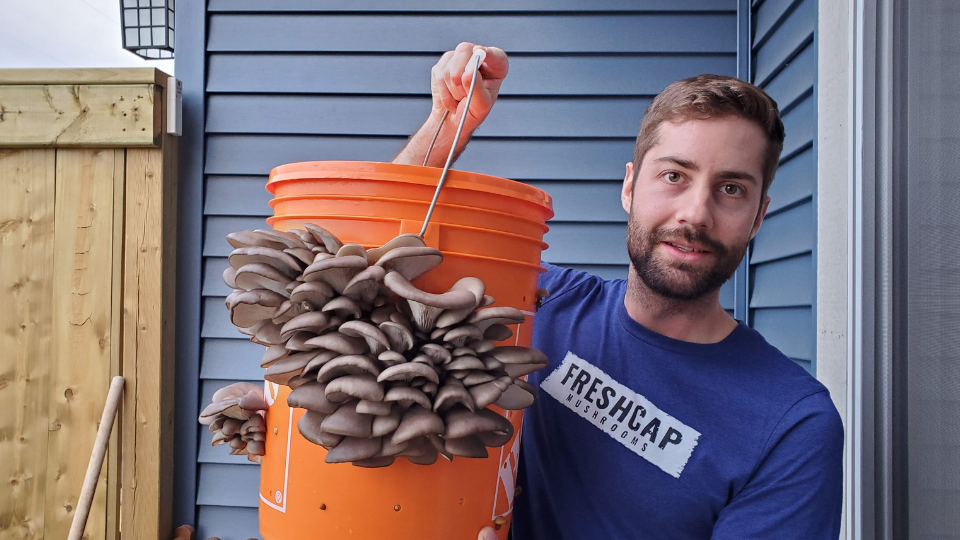
Mature outdoor grown Blue oysters in a 5 gallon bucket with drilled holes.
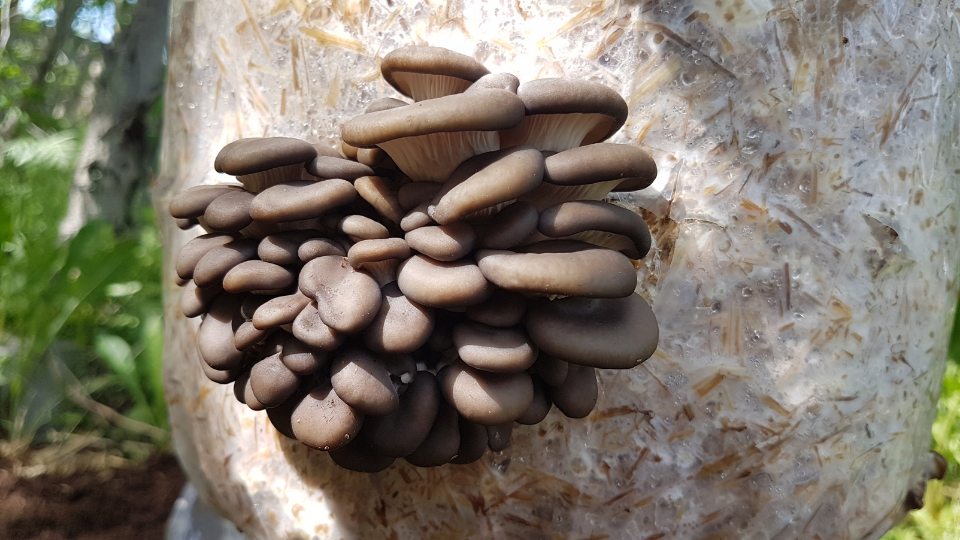
Blue Oyster mushrooms growing outside.
Yield:
Blue Oyster Mushrooms can achieve extremely high yields, up to 200% biological efficiency. Picking older mushrooms will improve the yield, but risks covering your grow room with spores or picking the mushroom past their prime for culinary use.
Harvest:
Harvest the mushrooms by picking of or cutting off entire clusters.
Mushrooms will store longer if handled delicately and stored as a cluster instead of picking off individual mushrooms. Blue Oysters will store longer in the fridge than pinks or yellows.
Blue Oysters have the tendency to continue growing in the fridge, with mycelium starting to grow from the stems. This is usually undesirable. Blue Oyster mushrooms can also be dried in a dehydrator for long term storage.
Weakness:
Blue Oysters have a huge spore load, more than any other mushroom.
They also have the largest fresh air requirement than any other gourmet mushroom, making it a bit of a challenge to grow large fruits indoors.
They last for a long time in the fridge but may start to grow mycelium from the stems. The stems can be chewy.
Cooking:
Blue Oyster mushrooms can be used in a variety of dishes, especially soups and pastas. The flavor is unique and delicious.
The stems can be chewy, and you may want to avoid using the stems in most dishes. Dried mushrooms can be re-hydrated in water or directly placed in soups and stews.
Growing Parameters
Spawn Run
Incubate at room temperature for 14 -21 days. Watch for water pooling in the spawn, or “sweating”.
Initiate Pinning:
Drop temperature to 15 deg C. Increase humidity to 95%. Should start to pin in less than 7 days.
Fruit Development:
Humidity at 85%. Temperature at 15-20 deg C. Grow fast, should produce harvestable fruits in 5 days or less from pinning.
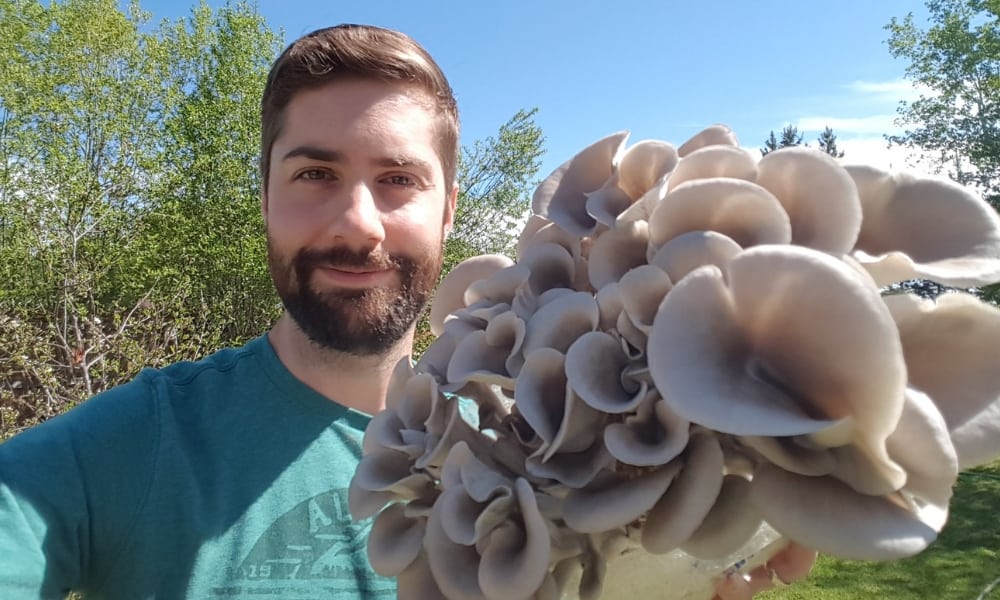
The Blue Oyster mushroom is a fun mushroom to grow at home. It grows fast and is satisfying to watch.
The initial blue color s stunning, and leads to large and delicious fruits. The mushroom is also a great choice for growing outside, producing much larger fruits with relatively low maintenance.
The mushroom also stores well for relatively long in the fridge, and can be dehydrated for long term storage.
Try growing blue oyster mushrooms today! Good luck with your grows!
